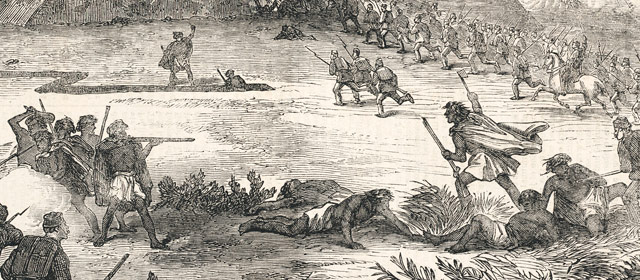Story summary
The New Zealand Wars were a series of mid-19th-century battles between some iwi and government forces (which included British and colonial troops) and their Māori allies, who were sometimes known as kūpapa.
Northland
In March 1845, Ngāpuhi led by Hōne Heke Pōkai and Te Ruki Kawiti attacked Kororāreka (Russell). Their forces fought British troops and other Ngāpuhi led by Tāmati Wāka Nene until January 1846.
Read more about the Northern war
Wellington
In July 1846 Governor George Grey arrested Ngāti Toa rangatira Te Rauparaha, who he accused of supporting attacks on settlers in Hutt Valley. Government forces pursued Ngāti Toa and their allies into the hills behind Pāuatahanui.
Whanganui
Tensions between Whanganui Māori and settlers were heightened in 1846–47 by the arrival of British troops, the wounding of a chief and the hanging of Māori who killed four Europeans. Upriver Māori attacked Whanganui town, but after a battle at St John’s Wood peace was agreed.
Read more about the Wellington and Whanganui wars
Taranaki
Many Taranaki Māori opposed land sales, and fighting began in 1860 over a disputed land purchase at Waitara. The British army and Pākehā settlers fought local Māori until March 1861.
In 1865 there were battles in South Taranaki, and in 1866 Major-General Trevor Chute led troops around Mt Taranaki, destroying Māori villages.
Read more about the North Taranaki war
Waikato
Waikato was the home of the Kīngitanga (Māori King movement). The government wanted to punish the king's followers who had fought in Taranaki, and to make Waikato land available to settlers. Troops invaded in July 1863. Fighting continued until April 1864, when the Kīngitanga and its supporters withdrew into what became known as the King Country.
Read more about the Waikato War
Tauranga
British troops were sent to Tauranga in 1864. Rāwiri Puhirake and Ngaī te Rangi repelled a British attack on Pukehinahina (Gate Pā) but were later defeated at Te Ranga.
Read more about Gate Pā, Tauranga
Prophetic movements
Māori prophetic movements emerged to resist land loss. Some tribes which opposed these movements formed alliances with the settler government. The British government began to withdraw its troops.
In 1864 supporters of the Pai Mārire faith attacked British forces in Taranaki and were defeated on Moutoa Island in the Whanganui River by Māori from down-river. Pai Mārire spread to the East Coast, where its supporters were defeated by local Māori and Pākehā forces.
Read more about Pai Mārire, South Taranaki and Whanganui
Tītokowaru
Ngā Ruahine leader Riwha Tītokowaru wanted to stop the confiscation of Māori land in South Taranaki. He fought government troops and Whanganui Māori in 1868–69.
Read more about Tītokowaru's war
Te Kooti
Te Kooti Arikirangi Te Tūruki (Rongowhakaata) was imprisoned on the Chatham Islands, where he developed the Ringatū faith. In July 1868 he escaped and returned to Poverty Bay with 297 followers. He fled inland and was pursued by Pākehā and Māori forces for nearly four years.
Read more about the Pursuit of Te Kooti
Long-term impact
Figures are uncertain, but about 560 British and colonial troops, 250 kūpapa and 2,000 Māori fighting against the Crown may have died in the wars. A total of about 1 million hectares was initially taken from iwi which had fought against the Crown, although some land was later returned.
Public awareness of the history of the wars has changed over the decades, particularly as new history books and television series have been released. The 150th anniversary of the Taranaki and Waikato wars saw revived interest in understanding and marking the wars and their long-term impact on the nation's history.
Read more about the long-term impact of the New Zealand Wars





